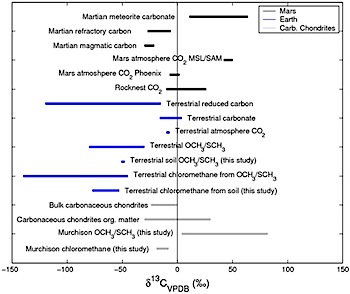 Organic matter recently detected by NASA’s robotic rover Curiosity [and much earlier by the Viking landers in the 1970s] is probably not due to contamination brought from Earth, as researchers originally thought. A team of German and British scientists now suggests [in a report published in Nature] that the gaseous chlorinated organic compound, chloromethane, recently found on the Red Planet most likely comes from the soil of Mars, with its carbon and hydrogen probably deriving from meteorites that fell on the planet’s surface. This assumption is supported by isotope measurements made by the scientists in which they replicated some of the Mars lander experiments. In these investigations, samples from a 4.6 billion old meteorite that fell in Australia in 1969 were used…. [More at links]
Organic matter recently detected by NASA’s robotic rover Curiosity [and much earlier by the Viking landers in the 1970s] is probably not due to contamination brought from Earth, as researchers originally thought. A team of German and British scientists now suggests [in a report published in Nature] that the gaseous chlorinated organic compound, chloromethane, recently found on the Red Planet most likely comes from the soil of Mars, with its carbon and hydrogen probably deriving from meteorites that fell on the planet’s surface. This assumption is supported by isotope measurements made by the scientists in which they replicated some of the Mars lander experiments. In these investigations, samples from a 4.6 billion old meteorite that fell in Australia in 1969 were used…. [More at links]
-
Recent Posts
Archives
Links
general
mission instruments
- CRISM: Compact Reconnaissance Imaging Spectrometer for Mars
- CTX: Context Camera
- HiRISE: High Resolution Imaging Science Experiment
- MARSIS: Mars Advanced Radar for Subsurface and Ionosphere Sounding
- SHARAD: Shallow Radar
- THEMIS: Thermal Emission Imaging System
missions
- All Mars missions list
- Curiosity rover
- ExoMars
- Hope (al-Amal) orbiter
- InSight
- Mars Atmosphere and Volatile Evolution Mission (MAVEN)
- Mars Exploration Rovers (MER)
- Mars Express (MEX)
- Mars Odyssey
- Mars Orbiter Mission (MOM) / Mangalyaan
- Mars Reconnaissance Orbiter (MRO)
- Mars Science Laboratory (MSL)
- Perseverance Rover
- Tianwen-1 orbiter/rover
news








